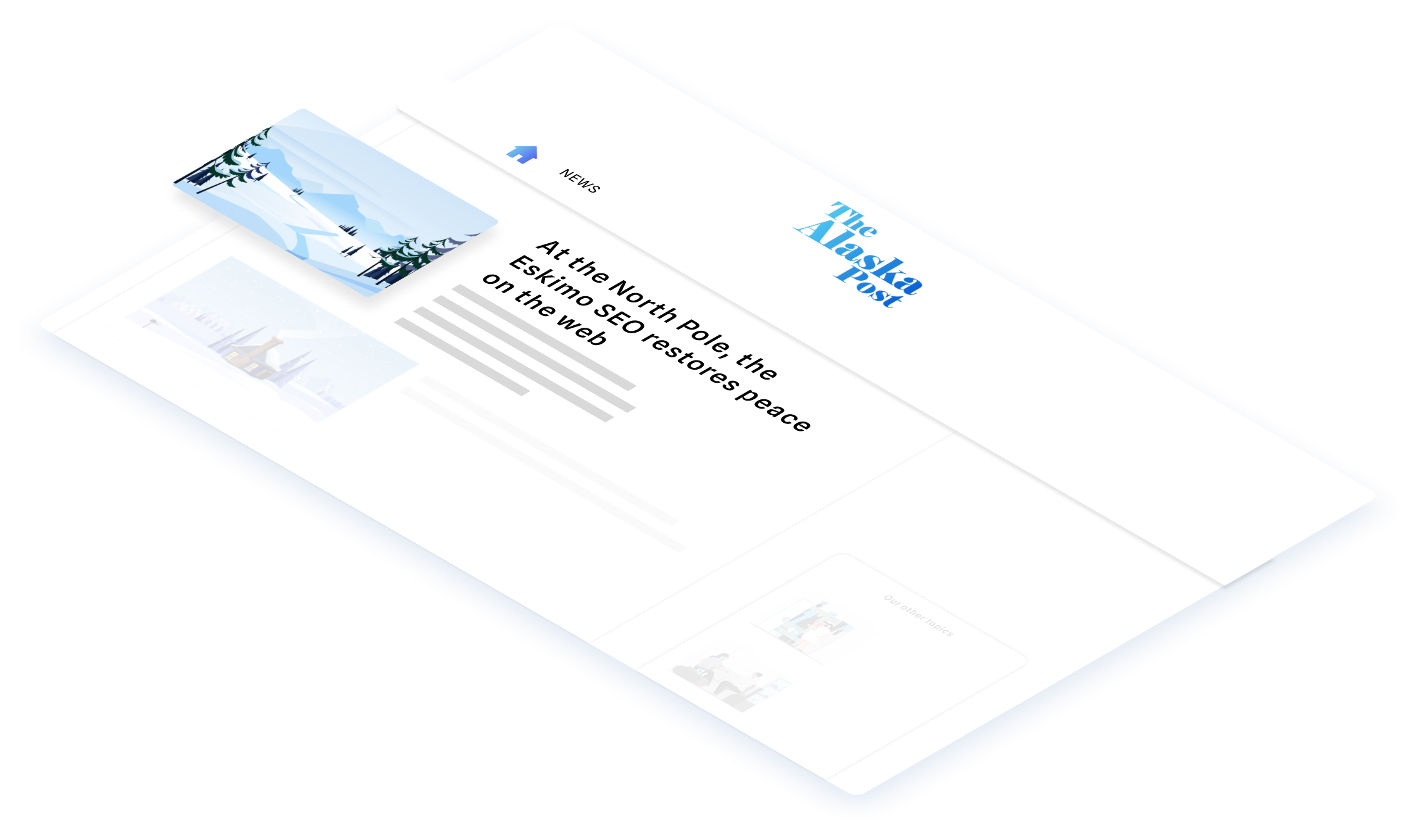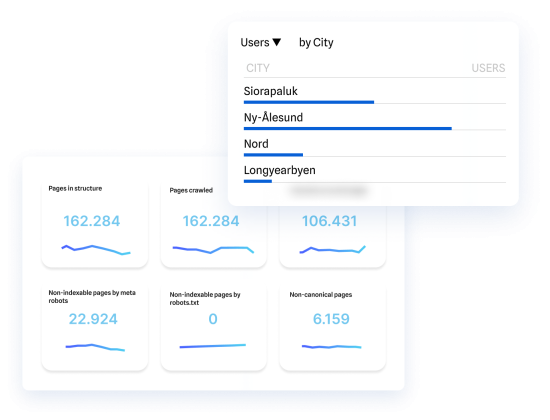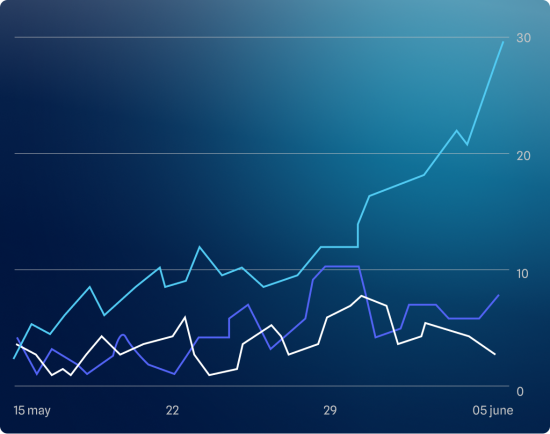
Blog posts: How to write an effective post
Blogging is an integral part of content strategy. Find out the secret to writing a successful blog article.

Define the key points of your strategy
Why write a blog article?
Anyone can write a blog article, individuals and professionals alike. From a marketing perspective, however, an article is never just an article: it is a single link in a large strategic chain aimed at achieving one or more objectives. It could be about, amongst other things, company or brand recognition, generating traffic to your website, encouraging Internet users to take a certain action (i.e. sign up for a newsletter, create an account, buy a product or service), gaining visibility on search engines, or establishing yourself as a leader in your specific market. It’s important to include blogging as part of a more global approach, because it truly is a big part of marketing.


The main components of a content strategy

-
STEP 1
Know your readership
Who is your blog aimed at? Your desired readership should be the audience you’re targeting with your marketing activities, whether it’s B2B or B2C. The readers of your blog are also your prospective clients, i.e. consumers likely to buy your products or services, or carry out a specific action.
-
STEP 2
Establish personas
What does your typical reader look like? Personas are the foundation of any good marketing strategy. They act as blueprints for your prospective clients, allowing you to target specific groups of people. In a blog, each article should be written with an “ideal” reader in mind, with clearly defined needs that the content should aim to meet.
-
STEP 3
Define your objectives
Why blogging? Your approach should aim to achieve clear, tangible and measurable objectives, whether it be gaining visibility, increasing traffic, increasing conversion rate, etc. Each blog article you write is a rung on a ladder leading to your goal.
-
STEP 4
Define your message
What do you want to get across to your readers? Behind every blog article, there’s a message being conveyed. This message must be “customer-centric” – focused on the consumer – and take into account their needs. A blog isn’t the place for self-promotion.
-
STEP 5
Choose your format
What’s the best format for you? Tutorials pass on practical knowledge. A list provides users with key information. An in-depth article shares expertise. You could also ask yourself whether the “article” format is even the best route – because it doesn’t have to be! A video, for example, may be more suitable.
-
STEP 6
Analyse the competition
What are your competitors doing? Content strategies are becoming increasingly common. Your direct and indirect competitors probably have one already. Identify those who publish blogs, analyse their approach, and try to do something different and/or better to grab the attention of their audience.
Good to know
The word “blog” is a contraction of “web log”. Blogs came with the emergence of the internet in the early 1990s. They were initially used to share thoughts and stories, but with the launch of WordPress in 2003 came an increase in blogging, which quickly took on a marketing dimension: professionals were now using it to communicate about their company or their brand.
-
77%
of internet users
read blog articles -
86%
of content marketers
use blog articles in their strategy -
600M
blogs
exist online
Identify the themes and topics you want to cover
Choosing your topics and themes
This is undoubtedly the trickiest aspect of blogging: identifying the major themes you’re going to cover and the specific topics to explore in each blog article. It’s a crucial first step because the goal is to capture the attention of your target audience, get them to read your content, and inspire them to take action. Therefore, it’s essential to determine which topics are likely to interest which audiences and push them in the desired direction. To identify relevant themes and define your topics, there are several possibilities: making use of current events, analysing search queries made by internet users, listing frequently asked questions by customers, analysing topics covered by competitors, and so on. Of course, themes are specific to particular industries – shoe sellers have no interest in talking about cars, nor do bakers care about management software.

How to build on your first blog article
The real challenge of blogging is consistency. Writing one, two, or three blog posts and stopping is not enough. A good strategy should be long-term. But how do you go beyond the first few articles once the main topics have been covered? How do you find material to write at least one blog post per week for a year or two? There are a number of good ways: you can create a semantic cocoon to exhaust a single theme by answering all possible questions that internet users can think of, you can divide a topic into several micro-topics to be addressed in shorter posts, or update an existing blog post with new information. You can also target a different audience with the same topic or even try a new approach to an old topic by using a different format.

What format to choose?
Format and topic are closely linked: you can start with a specific format to use and define a suitable topic, or start with a given topic and select the appropriate format. But first, it’s best to familiarise yourself with the different formats.
-
Informative article
The most basic blog post that provides information (general, specific, concrete, etc.) to its readers.
-
News article
Quick to produce, it relies on current events and can relate to the company’s industry, refer to a scheduled event, etc.
-
Long-form article
A long blog post that is characterised by its expert perspective. This content can generate traffic in the long term.
-
Tutorial/guide
Educational content that teaches the reader how to do something through a detailed step-by-step process.
-
Lists
Content that provides concrete added value to readers, with the advantage of getting straight to the point and making the most pertinent information more visible.
-
FAQ
Content that provides answers to common questions from users.
-
Storytelling
A personal story that differs from self-promotion. It focuses on telling the story/background of your company or brand.
-
Case study
Mainly used in B2B, case studies show a concrete application of a product/service and highlight what the company has on offer.
-
Testimonial
A point of view from a user or expert, providing concrete information to readers.
-
Opinion piece
A representative of the company takes a position on a given subject, and expresses their opinion, intending to generate debate, and even go viral.
-
Survey
A format specific to informative media that companies can use on their behalf to offer an in-depth analysis of a given subject.
-
Infographic report
A blog post that posts and discusses an infographic. This is a combination of formats that has the potential to go viral.
Check out our video on semantic cocoons
Tips for producing a high-performing blog post
Ensuring your blog article performs well
Writing online and writing on paper are two different things; something that should be kept in mind when writing content exclusively for online platforms. For a blog article to perform well, it must adhere to a number of rules and requirements. This includes the structure, which should follow the principle of the inverted pyramid: the main information goes in the first third of the content, and the secondary information in the remaining two-thirds, with a progression from general to more specific. Avoid walls of text – use short sentences, accessible language, and present well-organised ideas. Finally, the subheadings should be carefully crafted: readers have to be able to understand the article’s points by just scanning through it.

Adding value and fitting into an overall strategy
A high-performing blog post is content that adds value for its readers – they should be able to learn something or find answers to their questions. That’s why a content strategy should focus on creating potentially lengthy, but informative, articles (with a maximum of 20% promotional content), with examples, and capable of addressing topics in depth. You should also keep the strategy’s objectives in mind and complement the articles with engagement tools: call-to-action buttons, social media sharing buttons, etc.

Identifying the right keywords
A blog post also allows you to gain visibility on search engines through search engine optimisation (SEO). To do this, you need to develop a keyword strategy, which means identifying the queries made by internet users (your targets) on Google, among others, in order to work on these specific expressions and place them in the content’s HTML tags. This work allows search engines to correctly index the page and position it based on its relevance to the keywords typed. For example, a blog post titled “How to find skis for children?” could be a top result for the query “children’s skis.” (Of course in practice, things are a bit more complicated than that.) There are many ways to identify keywords: Google suggestions, associated questions, keyword planning tools, SEO tools, etc.
-
1240
is the average number
of words per blog article -
3
hours
is the average time taken to write a blog article -
60 %
of consumers
emphasise the importance of blog articles in the early stages of their buying process
Best practices for producing a blog article
How to write a blog article
The performance of a blog article is closely linked to its “digital” quality. But beyond the inverted pyramid structure, the importance of subheadings, and a style that should be accessible to as many people as possible, there are still a series of best practices to adopt when writing a relevant and effective article. These practices help to offer engaging and high-quality content while respecting online writing standards and establishing a distinct style, giving a “voice” to those producing them. Don’t forget: a blog is an online representative for the company or brand.

What are the best practices when writing a blog article?

-
STEP 1
A detailed plan
A good blog article relies on a clear and consistent structure. Ideally, this structure should be determined before writing even a single line and the content should be organised into sections and sub-sections to ensure it remains digestible and interesting from start to finish. It’s also important to ensure that the different sections are balanced.
-
STEP 2
An eye-catching title
The title is the key to the success of a blog article, and must therefore capture the reader’s attention. Typically, a provisional title is chosen in order to define the angle of the article before a definitive title is decided upon once the content has been written. Don’t hesitate to add expressions, emojis, and puns if it fits your editorial line.
-
STEP 3
A good introduction
The introduction aims to hold the reader’s attention and encourage them to continue reading. It should introduce the topic, provide the main key points of the article, ask questions, and specify how the article will answer them. Be careful not to reveal too much: the goal is to push the reader to read on!
-
STEP 4
Engaging content
There’s nothing worse than a boring, mundane blog article. Try to assert your writing style and add some volume to the content and liven it up a little. You should develop a style that is specific to your company, which corresponds to online writing standards, your industry, and what your target audience expects from you.
-
STEP 5
Appropriate formatting
Formatting consists of refining the blog article once it has been written. This involves working on its form (spaced text, balanced sections, coherent subheadings) as well as its SEO optimisation (HTML tags, title styles) and visual aspects (images, text colour, etc.). Don’t forget to place CTAs.
-
STEP 6
Thorough proofreading
The proofreading stage allows you to eliminate as many spelling, grammar, and style mistakes as possible. A blog article filled with errors and linguistic approximations is not very professional, so you should also ensure the consistency of the content and the quality of the text and information provided.
-
STEP 7
Effective visuals
Content that includes images gets 94% more views. It is therefore essential to illustrate the article with high-quality images that make sense and prioritise the main image that will be highlighted on social media publications. Visuals are also good SEO levers.
Good to know
There is no “correct” length for a blog article. Although SEO studies show that the best-positioned content tends to be longer (more than 1,500 words), this is not an absolute truth, and other parameters do come into play (such as competition on the keyword, for example). A “good” article should be complete, consistent, and meet its objectives, whether it is 600 or 3,000 words.
Adapt the article to the requirements of search engines
SEO: Increase visibility with your blog article
Each day, 27 million pieces of content are published on the web. So what do you need to do to stand out, increase visibility, and generate traffic with a blog article? After all, the purpose of web content is to be read by as many internet users as possible – ideally by those who looking for the information you’re providing. It is therefore important for it to appear in a good position in search engine results, and thereby activate organic SEO (search engine optimisation) channels: a set of actions with the aim of adapting the article to search engine requirements. SEO is fundamental when you consider that 93% of online experiences begin on a search engine (and that the first result on Google accounts for 32.5% of the traffic – source: SEJ).


What are the pillars of SEO optimisation?

-
Tags
Tags include the title, meta description, and Hn headings (applied to the main title and sub-sections). The first two appear in search engines.
-
Keywords
Integrating keywords into the tags and the body of the text allows the article to appear for specific queries. These keywords should be subject to semantic analysis.
-
Density
The ideal keyword density in a blog post is 1%, or one occurrence every 100 words.
-
Quality
The blog post must be relevant and well-structured. Search engines increasingly value qualitative and high-value-added content.
-
Internal linking
Creating internal links (between articles and pages of the same website) helps to improve site indexing and keep users on the site longer.
-
Backlinks
Incoming links (placed on third-party sites and pointing to the desired blog post) help boost natural referencing. This is called “link building”.
Check out our tips for writing optimised content
Find the right channels for your blog post
Write to be read
You have written an excellent blog post. It’s relevant, well-written, gives high added value to your reader, and is consistent with your company’s marketing strategy. It’s likely to position you as a leader in your industry. But if your target audience hasn’t read it, it becomes useless, bringing neither traffic nor prospective clients. So it’s very important, once written, to make the article visible. SEO optimisation is one way to do it, but there are others. It is therefore necessary to find the right channels to promote your article to potential readers and promote it so that it reaches its target audience.

How to effectively promote a blog post

-
STEP 1
Put the article on the front page
The first channel for promoting a blog post is the website that hosts it. Make sure that each new publication is automatically highlighted on the homepage of your professional website (or do it manually). Consider creating links within old content that point to the new article.
-
STEP 2
Choose relevant channels
There are various channels that can be utilised to distribute your blog article. Based on your target audience, you should choose the most relevant of these to share your blog post. For example, B2B content should be sent to your mailing list and shared on professional social networks like LinkedIn.
-
STEP 3
Publish on social media
When sharing a blog article on social media, it should be accompanied by a post. It should grab the attention of users and make them want to click on the link. Make sure you present the subject and indicate the benefits that readers can gain from reading your article.
-
STEP 4
Get the timing right
There are more and less favourable times to post your social media and e-mail campaigns. It can depend on the target audience: B2B emails are more likely to reach their target during the week, for example. Certain tools can be used to schedule the posting/sending to take advantage of ideal times.
-
STEP 5
Mix different formats
Certain formats work better on specific platforms. For example, videos tend to perform well on social media. Sharing a blog article can be more effective if it is accompanied by an engaging format, such as a video or infographic. This helps boost engagement rates and the number of shares.
-
STEP 6
Promote the article internally
It’s such an obvious distribution lever that we tend to forget it: company employees can contribute to the success of the marketing strategy by sharing the blog post on their own web platforms. To do this, it is important to let everyone know internally that this content exists and encourage them to share it.
Our Commitment
-
Expertise
Since 2010, we have worked with over 2000 clients across 90 countries.
-
Passion
We are a team of passionate, industry-focused individuals who are committed to your success.
-
Performance
We’re committed to implementing a data-driven strategy, making a real impact on your bottom line by providing avenues for growth.
Any questions?
An effective blog post should follow online writing standards, meet the SEO requirements from a search engine perspective, and fit within a pre-established marketing strategy. It should above all meet the needs and expectations of the targeted internet users and provide them with added value.
For a blog post, visibility is the key to success. To make it visible, it needs to be optimised so that it appears in the top search engine results, in response to specific queries made by internet users. This is the purpose of organic SEO work. Choosing the right keyword, its frequency in the article, and optimising the title tag are, for example, part of the best SEO practices to implement.
The choice of topic depends on several parameters: the sector of business, the profile of the targeted readers, the nature of the product or service, the prospective client’s needs, and the objectives.
Each blog post should address a specific topic, within a broader theme, and provide a solution to a specific problem.








